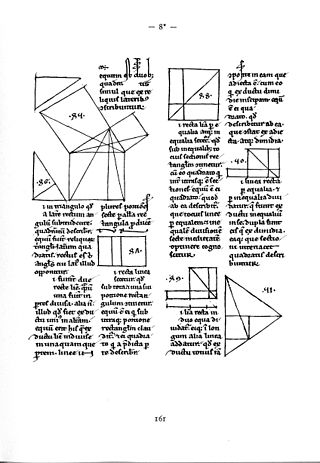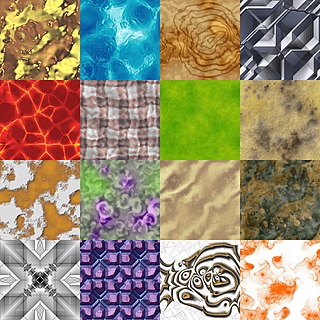
Wang tiles, first proposed by mathematician, logician, and philosopher Hao Wang in 1961, are a class of formal systems. They are modelled visually by square tiles with a color on each side. A set of such tiles is selected, and copies of the tiles are arranged side by side with matching colors, without rotating or reflecting them.
In digital signal processing, spatial anti-aliasing is a technique for minimizing the distortion artifacts (aliasing) when representing a high-resolution image at a lower resolution. Anti-aliasing is used in digital photography, computer graphics, digital audio, and many other applications.
Computational geometry is a branch of computer science devoted to the study of algorithms which can be stated in terms of geometry. Some purely geometrical problems arise out of the study of computational geometric algorithms, and such problems are also considered to be part of computational geometry. While modern computational geometry is a recent development, it is one of the oldest fields of computing with a history stretching back to antiquity.

In mathematics, a Voronoi diagram is a partition of a plane into regions close to each of a given set of objects. It can be classified also as a tessellation. In the simplest case, these objects are just finitely many points in the plane. For each seed there is a corresponding region, called a Voronoi cell, consisting of all points of the plane closer to that seed than to any other. The Voronoi diagram of a set of points is dual to that set's Delaunay triangulation.

Perlin noise is a type of gradient noise developed by Ken Perlin in 1983. It has many uses, including but not limited to: procedurally generating terrain, applying pseudo-random changes to a variable, and assisting in the creation of image textures. It is most commonly implemented in two, three, or four dimensions, but can be defined for any number of dimensions.
In computer graphics, texture filtering or texture smoothing is the method used to determine the texture color for a texture mapped pixel, using the colors of nearby texels.

In computer graphics, a shader is a computer program that calculates the appropriate levels of light, darkness, and color during the rendering of a 3D scene—a process known as shading. Shaders have evolved to perform a variety of specialized functions in computer graphics special effects and video post-processing, as well as general-purpose computing on graphics processing units.

In computing, procedural generation is a method of creating data algorithmically as opposed to manually, typically through a combination of human-generated content and algorithms coupled with computer-generated randomness and processing power. In computer graphics, it is commonly used to create textures and 3D models. In video games, it is used to automatically create large amounts of content in a game. Depending on the implementation, advantages of procedural generation can include smaller file sizes, larger amounts of content, and randomness for less predictable gameplay. Procedural generation is a branch of media synthesis.

In electrical engineering and computer science, Lloyd's algorithm, also known as Voronoi iteration or relaxation, is an algorithm named after Stuart P. Lloyd for finding evenly spaced sets of points in subsets of Euclidean spaces and partitions of these subsets into well-shaped and uniformly sized convex cells. Like the closely related k-means clustering algorithm, it repeatedly finds the centroid of each set in the partition and then re-partitions the input according to which of these centroids is closest. In this setting, the mean operation is an integral over a region of space, and the nearest centroid operation results in Voronoi diagrams.

Nearest-neighbor interpolation is a simple method of multivariate interpolation in one or more dimensions.

Filter Forge is a computer graphics program for Windows and Mac that allows users to create procedural textures and modify images. It can be used as a standalone application or as a plugin for compatible 8bf hosts such as Adobe Photoshop, Affinity Photo, Corel PaintShop Pro. It has been under continuous development by Filter Forge OÜ since its official release in March 2007.
Procedural modeling is an umbrella term for a number of techniques in computer graphics to create 3D models and textures from sets of rules that may be easily changed over time. L-Systems, fractals, and generative modeling are procedural modeling techniques since they apply algorithms for producing scenes. The set of rules may either be embedded into the algorithm, configurable by parameters, or the set of rules is separate from the evaluation engine. The output is called procedural content, which can be used in computer games, films, be uploaded to the internet, or the user may edit the content manually. Procedural models often exhibit database amplification, meaning that large scenes can be generated from a much smaller number of rules. If the employed algorithm produces the same output every time, the output need not be stored. Often, it suffices to start the algorithm with the same random seed to achieve this.
Function Representation is used in solid modeling, volume modeling and computer graphics. FRep was introduced in "Function representation in geometric modeling: concepts, implementation and applications" as a uniform representation of multidimensional geometric objects (shapes). An object as a point set in multidimensional space is defined by a single continuous real-valued function of point coordinates which is evaluated at the given point by a procedure traversing a tree structure with primitives in the leaves and operations in the nodes of the tree. The points with belong to the object, and the points with are outside of the object. The point set with is called an isosurface.

Natural neighbor interpolation is a method of spatial interpolation, developed by Robin Sibson. The method is based on Voronoi tessellation of a discrete set of spatial points. This has advantages over simpler methods of interpolation, such as nearest-neighbor interpolation, in that it provides a smoother approximation to the underlying "true" function.
Gradient noise is a type of noise commonly used as a procedural texture primitive in computer graphics. It is conceptually different from, and often confused with, value noise. This method consists of a creation of a lattice of random gradients, dot products of which are then interpolated to obtain values in between the lattices. An artifact of some implementations of this noise is that the returned value at the lattice points is 0. Unlike the value noise, gradient noise has more energy in the high frequencies.

Mathematical diagrams, such as charts and graphs, are mainly designed to convey mathematical relationships—for example, comparisons over time.

In computer graphics, a procedural texture is a texture created using a mathematical description rather than directly stored data. The advantage of this approach is low storage cost, unlimited texture resolution and easy texture mapping. These kinds of textures are often used to model surface or volumetric representations of natural elements such as wood, marble, granite, metal, stone, and others.
This is a glossary of terms relating to computer graphics.
Noise refers to many types of random, troublesome, problematic, or unwanted signals.
The jump flooding algorithm (JFA) is a flooding algorithm used in the construction of Voronoi diagrams and distance transforms. The JFA was introduced by Rong Guodong at an ACM symposium in 2006.













